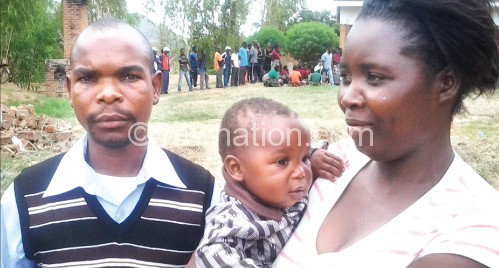Man in the maternity world

The country is buzzing with by-laws that aim to enhance male involvement in motherhood. But what does it mean to be a man in what is traditionally perceived as a woman’s zone—the delivery room? JAMES CHAVULA meets Gibson Gondwe and more.
What do you call men frequently spotted in supposedly women gatherings?
Like many African cultures, the Tumbukas of northern Malawi have fashioned a range of demeaning names for the so-called chili pa banakazi or banalume bakuzelezeka who are usually deemed lesser men for taking women as their equals.
But it is by swimming against the tidal cultural stereotypes that Gibson Gondwe has become a real man—a beaming example of how the male folk must be involved in promoting safe motherhood and preventing mother-to-child transmission (PMTCT) of HIV.
“What does it benefit a man to be called a man when he cannot stand by his most loved partner when she needs him most?” wondered Gondwe, 31.
Since the birth of their third-born in 2012, Gondwe and his wife Esther have become a model couple in Chimwazi Village, Paramount Chief Chikulamayembe in Rumphi.
They are not your usual lovebirds. Married in 2003, the two nearly separated four years later due to widespread pressure from the man’s family and friends who couldn’t stomach seeing them childless.
However, the parents of three spectacularly calmed the mounting social demands in 2008 when Esther conceived. She gave birth to Goodall, 5, pushing the doubters to the side.
“The birth of the first born might have dispelled all the doubts society had about our fertility, but I ended up having another baby in 2010 and the third in 2012 just to ascertain that I was really the father of the children,” said Gondwe.
The doubts are not strange in a society where some cultures pressure barren men to temporarily surrender their wives to their potent colleagues, called fisi (hyena), to meet the relentless demand for children.
However, it was the third pregnancy that made Gondwe to go to the delivery room where most men fear to peep—thanks to a phone call summoning him to Bolero Health Centre when Esther was pregnant.
“She phoned to tell me that health workers had declined to attend to her unless I was by her side. I rushed to the health facility and escorted her to a private room where we pep talk about safe motherhood and tests for sexually transmitted infections, including HIV,” he said.
The tests are in line with the Ministry of Health guidelines on reduction of maternal mortality and prevention of mother-to-child transmission.
But the experience was a day well spent in the maternity room where he said he put on gloves and rendered a hand to the skilled birth attendants “when the wife looked weak and the opening was too narrow for the baby.”
This was a man, a breadwinner, who has grown up thinking escorting women to the hospital is a waste of time, a shameful act.
Today, his wife proudly proclaims that her husband, apart from shattering the misconception that men’s job ends at conception, has become more loving and understanding after glimpses of her experience in the life-or-death room.
“I thank him for being there for me and setting an example for most men who stop being responsible when the woman becomes pregnant. After witnessing the birth of our third baby, he respects me and involves me in making key decisions about our marriage and lives,” said Esther.
Among the decisions, the two have agreed never to have another baby until the third born is five years old.
With just a year to 2015, when the deadline expires, the wife confesses repeatedly overhearing her husband telling friends that the baby could be their last born after all.
“I was happy to see him heed advice from health workers and taking part in ensuring the safety of our baby. We really needed to take a break because we have nothing to prove, except love and respect for each other. With almost equal understanding of what it takes to have a child, we have renewed our commitment and respect for each other’s wellbeing,” said Esther.
Only time will tell whether the renewed commitments include insisting on contraceptive methods beyond 2015.
However, the success story of male involvement did not come out of the blues.
Health workers at Bolero credit this to a mix of government policy and incentives from a local non-governmental organisation (NGO). Noting with concern the problem of male apathy to maternal issues and PMTCT, Ministry of Health guidelines require women who report to health facilities with their husbands to be the first in while those who come as singles stand on the queue—explaining the long wait that compelled Esther to pick the phone and call her husband.
Besides, Life Concern Organisation (Lico), in conjunction with the health centre, has been distributing plastic buckets and papers—the two sanitation tools women need when delivering—to couples that fully involve men.
But there is need for communities to come up with by-laws on safe motherhood and PMTCT because incentives are hardly sustainable, says Lico executive director Peter Gondwe.
“The likes of Gondwe and his wife are testimonies that the incentives were successful, but communities need to come up with binding ways of cementing the inroads because health facilities may not have the muscle to sustain the incentives when our funding is over,” said Gondwe recently at Mzokoto Health Centre during the launch of community by-laws on PMTCT.
The by-laws spell out obligations for men, pregnant women and traditional leaders to ensure that no life is lost or exposed to HIV during childbirth. They also include a flurry of penalties: A fine of one chicken or K3 000 (US$7) when a woman shuns antenatal services; three chickens or K9 000 (US$22) for men who do not escort their wives to the nearest health centre and a goat or K20 000 (US$48) for delivering at home.
The by-laws also empower senior traditional leaders to determine fines for village heads who stand aside and look on while women or children die.
Principal Village Head Chiling’ombe said the by-laws are a result of frank discussions by traditional leaders and area development committees whose recommendation were endorsed by Rumphi district commissioner on September 20 2013 and unanimously adopted on November 30 2013.
“Every life lost while giving birth is a result of failure at all levels of our society which values women and children. For years, we have seen women dying while giving birth at home or on the roads to the hospital. We easily bought into the idea to formulate by-laws because we cannot let this continue,” said Chiling’ombe.
Agreeing with Chiling’ombe, Traditional Authority (T/A) Mwankhunikira said he is no stranger to the sight of women giving birth at home, some of whom have died of severe bleeding or rapture of the uterus at the hands of unskilled birth attendants.
Figures from the Ministry of Health show that 675 of 100 000 women in the country die while giving birth—particularly due to delays to seek health services.
“Some babies might have contracted HIV in the process,” said Mwankhunikira who sits on the Presidential Initiative for Safe Motherhood.
He envisages that the by-laws will force more men to take part in ensuring that all childbirths are safe, that no child gets HIV from the mother.
Equally upbeat is Mzokoto Health Centre in-charge Mercy Chikaphupha.
“Looking forward, we see deliveries happening at home no more, that more and more women will be encouraged by their partners to present themselves to the nearest clinic in time so that they can deliver at the hands of skilled health workers, not traditional birth attendants. Even access to HIV testing and adherence to ARVs will improve,” she said.
Most importantly, Chikaphupha said male involvement, which has been elusive for years, is a key catalyst in ensuring government guidelines on PMTCT achieve their goals.
The guidelines require every pregnant woman to be tested for STIs, including HIV and syphilis. When diagnosed HIV positive, the woman starts taking antiretroviral drugs straight away.
After seven months, the mother receives the life-prolonging drugs for the baby. When the new born spans six weeks old, it undergoes an HIV test.
“Figures at Mzokoto show that of 10 children born to mothers with HIV, nine are born without the virus,” said Chikaphupha, explaining that “the major tragedy when men are not involved is that some women shun the test and don’t take the life-prolonging drugs because they fear their husbands.”
The slashed mother-to-child infection rates is the reason Rumphi district Aids coordinator Blessings Kanyangale likens the sanctions aimed at entrenching prevention of mother-to- child transmission in the tobacco-growing stretch to watering a nursery.
“Controlling transmission from parents is the only way we can hope to achieve zero new infections among future generations,” said Kanyangale, describing the levels of mother-to-child infections as very high.
Yet, by-laws, like other laws, are just what they are—paper and ink. Kanyangale said there is need for coordination from traditional leaders to men at household levels, to domesticate, popularise and implement the by-laws to achieve the desired results.





